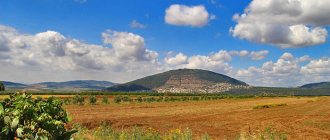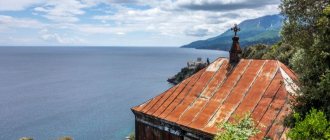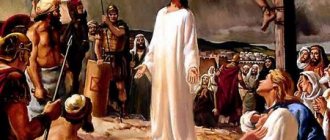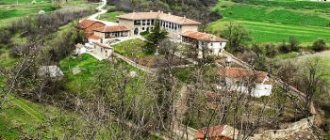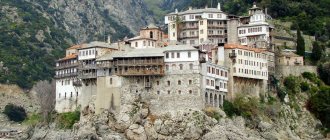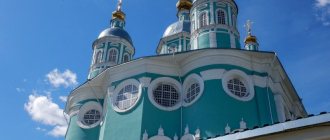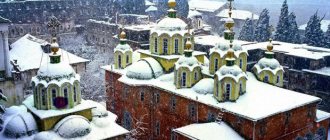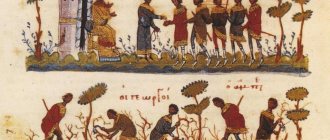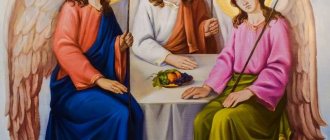The legendary Mount Tabor is visible from afar, it stands out sharply against the background of the surrounding landscape, majestically and illogically rising to the sky 588 meters among low hills, like a lonely round cone, like the navel of the earth. Its slopes are covered with lush green plants: olives and oaks, oleander and hazel, jasmine and wild roses, and in the spring the mountain is strewn with a variety of colorful flowers. A narrow road winds towards the almost flat peak, along which tourists and pilgrims walk and drive cars, wanting to see the place where one of the greatest biblical miracles happened, because Tabor is the mountain of the Transfiguration of the Lord.
How to get there?
The easiest way to get to Favor is by personal or rented car, which can be rented in any major city. The main thing is to do this on a weekday, since rental companies may not work on Saturday and Sunday. Regular buses to these places go poorly and inconveniently: they either pass near the mountain at night or stop too far from it. You can get there from Tiberias or Nazareth by taxi for a reasonable price.
The best option for most vacationers is group excursions with a guide, which are arranged by travel agencies from major Israeli cities. The excursion can be booked in advance on the Internet by selecting the desired date and time, at the same time it will be possible to learn the trip program in detail and better prepare for it.
Due to the narrow road, the route to Tabor is closed to buses; they drop off passengers at the foot of the mountain. Then you can use minibuses and taxis with Arab drivers or make the ascent on foot. There are two walking routes, 5 and 3 kilometers long. Both are rich in amazing views and wonderful nature.
Ancient history
Scientists are still arguing about the origin of the name of the mountain. According to the main version, the word “Tavor” comes from the Hebrew word “Tavor”, meaning “navel”, a clear allusion to the shape and isolated location of the hill. Mount Tabor went down in history long before Christian times. The fact is that it was located next to the most important trade route from Egypt to Mesopotamia through Damascus. Whoever owned this commanding height controlled the Great Sea Route. It is not surprising that there was a constant struggle for Favor.
One of the sad pages of the Jewish people is connected with the mountain. During the Jewish Wars, fleeing the Roman legions, Galilean Jews under the leadership of Josephus created powerful fortifications on the mountain with impressive walls and deep ditches. The Romans were unable to subdue the defenders of Tabor by force, tripled the multi-day siege, and then promised to pardon the defenders if they laid down their arms. The thirsty warriors agreed, but were deceived and, as a warning to other opponents of the Empire, they were cruelly executed - crucifixion along the road leading from Tabor.
Mount Tabor: Transfiguration of the Lord
But the main event that happened here was something else. Of course, this is the Transfiguration of the Lord on Mount Tabor. Although skeptics doubt that the Savior revealed his divine nature on this mountain, true believers are sure of it. Thousands of pilgrims strive to climb the mountain and worship the place where almost twenty centuries ago, shortly before his death on the cross, the Son of God ascended along with three disciples: Peter and the brothers John and James.
At the top of Tabor, during prayer, the future apostles witnessed the Transfiguration of their teacher into God. His clothes and face shone with a wonderful light, and then the great prophets of the past appeared: Elijah and Moses. The miracle shocked the disciples to the depths of their souls and gave them the strength that allowed them to maintain their dignity and not lose faith during the Crucifixion and the unbearable suffering of the Savior.
Dispute over a holy place
Mount Tabor.
Late 17th century engraving from wikimedia.org By the 14th century, the authentic site of the Transfiguration of the Lord was already causing controversy. The Orthodox considered the authentic place in their monastery, the Catholics - in theirs. The head of the Russian Spiritual Mission in Jerusalem, Archimandrite Porfiry (Uspensky), discussed this.
“Each religion assigns to its monastery the area where the Savior was transfigured. I do not confirm or deny either one or the other legend. It is enough for a Christian to believe that the Lord was transfigured on the elevation of Tabor, and to pray to Him for the enlightenment of the soul and eternal salvation.
And the event took place not on one yard of land, but on the entire mountain. The light was visible from a distance; the voice was heard far away; the cloud overshadowed the whole mountain; a voice from heaven was heard throughout the mountain. So the whole top of the mountain is sacred.”
The first temples
After the death and Ascension of Christ, more and more people were converted to a new, saving religion. The news of the Transfiguration spread among the first Christians, and Mount Tabor became the place of their worship of the Almighty. Gradually, Christianity gained strength and attracted not only the poor, suffering sections of the population, but also influential, wealthy patrons. Such were the first Christian ruler - Emperor Constantine and his mother Helen, who deeply and recklessly believed in Christ like a woman.
For her work in spreading and defending Christianity, the queen was subsequently canonized. It was she who brought her crowned son to the faith of Christ, she protected the clergy from persecution of the pagans, and at her command they built churches. By the will of Queen Helena, the first temple appeared on sacred Tabor - the Mount of Transfiguration - at the beginning of the 4th century, thanks to which the interest of pilgrims in this place increased significantly. By the 9th century there were already four temples and a monastery on the mountain.
But the prosperity did not last long. In the eleventh century, the era of the Crusades began. Palestine became the site of bloody religious wars. Mount Tabor once again became a key strategic height. Dark days have come for Christian churches. They were destroyed, rose from the ruins and again fell into ruin.
In 1099, the army of the crusader Tancred captured the mountain. A fortress was erected on it, and then a Catholic church. In 1113, the Saracens destroyed all Christian buildings and killed priests and monks. A few years later, the monks returned and began to restore the Tabor monastery and temples, but in 1187 the mountain was again conquered by the Muslim troops of the brilliant Sultan Saladin. Mount Tabor then changed hands several times until the Crusaders suffered a final defeat in the Holy Lands. In 1263, by order of Sultan Baybars, temples and monasteries were completely razed, and Christians left the Mount of Transfiguration for several centuries.
New life of Mount Tabor
Until the 17th century, only a few pilgrims climbed the mountain, but in 1631 the Druze emir graciously allowed Franciscan monks to begin excavations at the site of the destroyed temples. This became the starting point of a new life for the holy place. True, it took Christians another two centuries to finally return to the Mount of Transfiguration. Moreover, first, in 1862, an Orthodox monastery appeared here thanks to the efforts of a modest Moldavian priest, Archimandrite Irinarch, and in 1924, a monumental Catholic basilica began to operate on the top of Tabor.
Orthodox church
In 1844, a quiet monk, Archimandrite Irinarch, settled on the top of Tabor, who quickly became famous among the local population and pilgrims for his devout faith and responsiveness. Irinarch did not refuse anyone a blessing, confession, or spiritual help. For his asceticism and wisdom, the priest won respect even from Muslims.
The archimandrite lived a calm, bright life: he prayed, served together with a student a prayer service for pilgrims in the ruins of an ancient Byzantine temple, but then decided, with God’s help, to build a new church on these ruins. It would seem an exorbitant task for two people, but Irinarh was not afraid.
At first, things went slowly, the builders did not have enough strength and money, but gradually wealthy pilgrims and wealthy residents of Galilee began to provide financial assistance. Then the news about the amazing monk reached Jerusalem, the patriarchs of the Orthodox churches (Greek and Russian) found the necessary funds to complete the construction of the temple.
In 1862, on the day of the Transfiguration of Christ, the church was consecrated by Patriarch Kirill of Jerusalem. Archimandrite Irinarchus did not live to see this day, but his services are invaluable. There is a memorial plaque installed in the temple, which tells about the contribution of the modest but active monk and the fact that he rested next to his brainchild.
The Orthodox church took on its final appearance in 1911. Today on Tabor there is a convent and the Church of the Transfiguration, which attracts with its painted vaults, the stone on which Christ stood at the moment of the Transfiguration, and the miraculous icon of the Mother of God, called the “Unfading Light” and which has an amazing history.
The icon was caught in the sea, it was sealed in a bottle and represented an image of the Mother of God on thin paper rolled into a tube. The inconspicuous, mysterious icon began to miraculously help seriously ill people who had practically lost hope of recovery. Therefore, the icon is covered with photographs and plates with the names of patients who need the help of the Mother of God, and is also hung with jewelry in gratitude for deliverance from the disease.
On the territory of the monastery there are symbolic tabernacles that the disciples of Christ, shocked by the miracle, wanted to build for the teacher and two prophets who descended from heaven. Near the temple, a small cave awaits tourists, in which, according to legend, the mysterious hermit king Melchizedek lived.
Nowadays
Ancient history has left its mark on this wonderful place: it is always filled with pilgrims and tourists who want to get closer to the wonderful Divine Transfiguration.
A visit to these places makes it possible to feel the presence of God here and touch the ancient walls of the temple. It is interesting not only to read, but also to see with your own eyes that mysterious cloud covering this sacred place, which has been called Mount Tabor since ancient times.
Israel sacredly guards all the shrines collected here and respects all religions that are represented in these wonderful places. Today, on the top of Tabor there are two monasteries - Orthodox and Catholic.
Orthodox monastery
The Orthodox monastery owes its creation to Archimandrite Irinarch (formerly a resident of the famous Lavra of St. Savva). He had a vision, after which he settled on the top of a mountain, where he soon found the remains of an ancient Byzantine temple.
This was probably the same church that Queen Helena ordered to be built. Irinarch set about restoring the temple, which was then consecrated in 1862.
One of the famous shrines of this place is the Unfading Flower icon. It depicts the Virgin and Child holding a flowering branch in her hand. This icon is very different from the images that we are used to seeing in our local churches - unlike them, the image of the Mother of God does not have bright colors, and it is printed on simple newsprint.
At one time, the icon was caught from the sea by Arab children; it was carefully rolled up and sealed in a bottle. No one knows where she came from. However, the help coming from the icon of the Unfading Color, like a magnet, attracts crowds of believers here every day.
Catholic monastery
Appeared here at the end of the 19th century. It is located on the territory where in the 13th century there was a fortress built by Muslims.
Also preserved here are the ruins of a temple of Latin monks, the ruins of a monastery from Byzantine times and other sacred places that Mount Tabor hides. The Temple of the Transfiguration is the greatest architectural discovery of Antonio Barluzzi.
The artist created a basilica here that is stunning in its beauty. It bears the name of a miraculous event - the Transfiguration of the Lord. The road leading to the temple reveals ancient ruins to pilgrims - evidence of past eras, which Mount Tabor has preserved to this day.
The Church of the Transfiguration has two towers that divide the entrance to the basilica into two parts and are located above the ancient chapels. One is named after the prophet Moses, and the second is named after Elijah.
From this place the huge temple building begins, leading to the main place - the altar. Parishioners are led here by descending marble steps, which reveal an ancient place - the ruins of a Byzantine basilica that was previously located here.
Cloud descent onto Mount Tabor
Every year on August 18, one day before the start of the Feast of the Transfiguration of Christ, many pilgrims begin to flock to the Tabor Orthodox Church. They all want to witness an unexplained phenomenon. For many years now, during a festive service, a strange cloud has suddenly descended on the Orthodox church and monastery of Mount Tabor, in which sparks, stars and flashes flash from time to time.
As a rule, in August the weather in Galilee is dry and cloudless; sometimes there are no clouds in the sky for days, which makes this phenomenon even more incredible. Scientists have tried many times to unravel the mystery of the cloud on Mount Tabor or to debunk it as a myth, but were forced to admit that the phenomenon really exists and there is no rational explanation for it. Another interesting nuance: the cloud of grace descends only on the Orthodox church, approaching the Catholic basilica, it disappears. Moreover, when Catholics celebrate the Feast of the Transfiguration of Christ on Mount Tabor two weeks earlier, the cloud does not appear.
Therefore, it is not surprising that Orthodox believers from many countries come here. With anxious anticipation, they stand for several hours of the night liturgy, at the end of which they become accomplices in the miracle of Mount Tabor. The air suddenly thickens, candles and people lose their clear outlines, as if they are caught in a strip of heavy fog. The worshipers are overwhelmed with religious reverence, priests and pilgrims begin to read prayers in unison to the glory of God. They probably experience partly emotions similar to the feelings of the three apostles who saw the Transfiguration on Mount Tabor.
The next day, Favor is again bathed in greenery and sunlight that pours from a cloudless sky. And exactly one year later, a mysterious cloud again descends on the temple to strengthen the Faith of the people present in it and to testify to the special role of the Mount of Transfiguration in God's providence.
Annual miracle
Every year on the eve of the Transfiguration, which is celebrated on August 19, hundreds of Orthodox pilgrims and tourists from different countries flock to this place. Here you can meet Russians, Ukrainians, Greeks, Bulgarians, Georgians, eager to witness the miracle on Mount Tabor, which can be observed here on this day every year.
Those who want to see it with their own eyes climb the mountain in advance, on August 18, to watch the sunrise at its peak.
Representatives of the Jerusalem Patriarchate serve a festive service, which has to be held not in the monastery church itself, but on a specially equipped area in front of it, since the walls of the church are not able to accommodate a huge crowd of worshipers.
After the Liturgy is celebrated, the same event takes place every year: the descent of a cloud occurs - a phenomenon that science is unable to explain. As witnesses of the miracle note, a light cloud appears above the crowds of believers, which, increasing in size, gradually descends on the praying people.
All Christians strive to experience this manifestation of Divine grace. Visiting Tabor is a dream not only for believers. Most people interested in culture and history want to come here. And it's worth it. Once you are here, it is impossible to forget this place.
Source: https://yofi-tofi.ru/kulturnyj-otdyx/dostoprimechatelnosti-izrailya/329-gora-favor.html
Catholic basilica
To get to the domain of the Catholic monastery and basilica, you must first overcome the Tabor plateau, which looks like a marvelous park, pass the Orthodox monastery, and then go through the ancient Gate of the Winds. The basilica delights with the beauty of its architecture and the majesty of its size. It is considered the best work of the famous Italian - Antonio Barluzzi, who created more than two dozen temples and chapels in Palestine.
The basilica was built in the Byzantine style with elements of Syrian architecture intertwined on the site of the ruins of a Catholic church from the times of the Crusaders. It is beautiful both in appearance with its two-tower facade and in the interior, in which the original touch is the two chapels located in the towers and dedicated to the prophets Elijah and Moses.
Mosaic images of the interior, according to Catholic custom, are dedicated to the stages of the Savior's Way of the Cross, but the dominant place is occupied by mosaics with scenes of the Transfiguration on Mount Tabor. The Monastery of the Transfiguration of the Lord is open to visitors; on its territory there is a beautiful chapel and a well, on the site of which, according to the monks, Christ told the disciples to keep silent about the miracle they saw for the time being.
Bottle icon
The local Orthodox church was consecrated in 1862. Next to the church there is a functioning Greek convent of the Transfiguration of the Lord.
The main shrine and the main attraction of this outwardly modest temple is the striking Akathist icon, or the Unfading Blossom (the Virgin Mary holds a flowering branch in her hand). Her story is like something out of an adventure novel about sea adventures and uninhabited islands. One day, Arab children, playing on the shores of the Kinneret, found a sealed bottle.
The mystery of the bottle also intrigued adults: there was an icon of the Virgin Mary neatly rolled into a tube. A very strange icon, on thin, newspaper-like paper. Where the color original of the icon is, whether it existed at all, who and why sent the bottle with such a “message” to sail is unknown.
The icon was brought to the Orthodox church on Tabor, and now it “lives” in the main altar of the church, dedicated to the Transfiguration (the other two are dedicated: the southern one - to the Jews Moishe and Eliyahu, the northern one - to the popular Orthodox saints George Demetrius of Thessalonica).
The icon is miraculous, it heals. And now it is constantly framed with photographs - they are attached by pilgrims praying for the healing of sick relatives and friends.
Source: https://www.ru.israland.travel/mountain-favor
Favor today
Israel is a compact country with excellent transport infrastructure, which allows you to get to Tabor quickly and comfortably, which is why it is often included in excursion programs. Every year, the Mount of Transfiguration is visited by thousands of tourists who want to walk along the slopes on which the Savior walked, to look at the place where He was first transformed before people.
Favor is a unique example of religious tolerance and peacefulness: Catholic and Orthodox monks, Jews and Muslims coexist here without conflict. Local residents, both Arabs and Jews, love to organize picnics and holidays on the mountain. The nuns of the Orthodox monastery are famous for their hospitality: they treat those who wish to free tea, juice, coffee, and pastries. In addition to temples, tourists can enjoy souvenir shops and cafes.
And of course, Favor is an exotic, diverse, vibrant nature, parks and gardens, as well as unforgettable views of the Galilee. They open up as you climb the mountain, but are especially good from the observation deck located on the basilica. From here you can see in detail the Jezreel Valley, Nazareth, the Sea of Galilee, and a chain of nearby mountain ranges.
origin of name
Favor means "separate." There are other meanings of the word, for example, a convex place on the plain and “navel”. Some researchers are inclined to believe that this is what gave rise to the phrase “navel of the earth.”
The mountain looks the same from all sides, like a huge haystack. Only its apex is oblong, slightly concave, like an eye socket.
It is possible that on the eve of the Nativity of Christ, in Galilee, there were other high hills that collapsed over time. After all, for a long time, emphasizing something sublime and special, they talked about the Mount of Transfiguration. For example, the ancient poet Jeremiah, comparing the Egyptian king with other rulers, emphasized that he was like Tabor between other mountains.
